Zyxel NWA3560-N User Manual [ru]
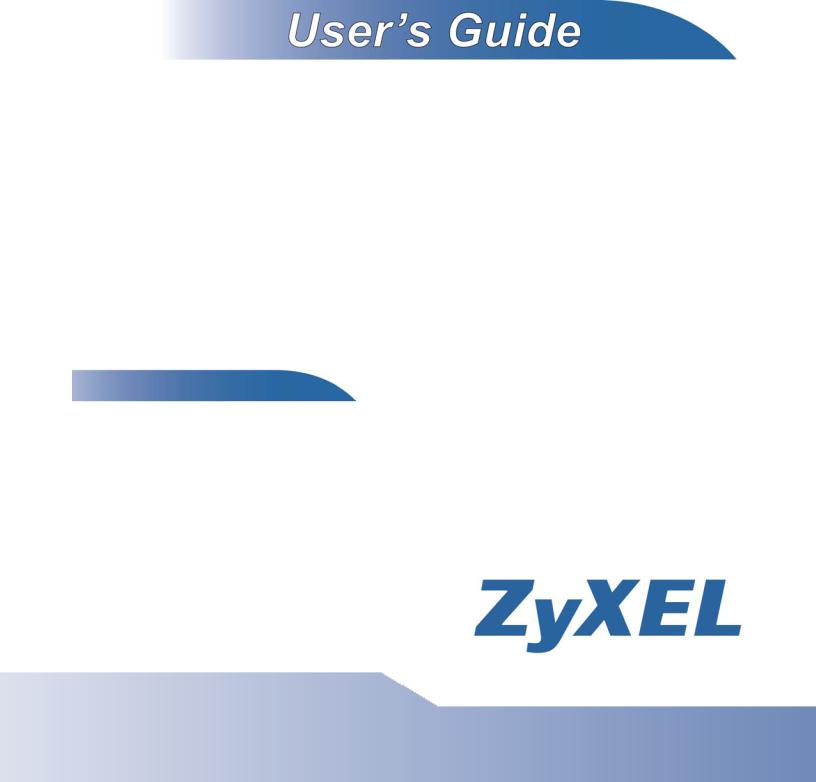
NWA3000-N Series
Wireless N Business WLAN 3000 Series Access Point
Default Login Details
IP Address |
https://192.168.1.2 |
User Name |
admin |
Password |
1234 |
|
|
Version 2.23
Edition 1, 1/2011
www.zyxel.com
Copyright © 2011
ZyXEL Communications Corporation

About This User's Guide
About This User's Guide
Intended Audience
This manual is intended for people who want to configure a NWA3000-N series AP using the web configurator. You should have at least a basic knowledge of TCP/IP networking concepts and topology.
Related Documentation
•Quick Start Guide
The Quick Start Guide is designed to help you get up and running right away. It contains information on setting up your network and configuring for Internet access.
•Support Disc
Refer to the included CD for support documents.
•ZyXEL Web Site
Please refer to www.zyxel.com for additional support documentation and product certifications.
User Guide Feedback
Help us help you. Send all User Guide-related comments, questions or suggestions for improvement to the following address, or use e-mail instead. Thank you!
The Technical Writing Team,
ZyXEL Communications Corp.,
6 Innovation Road II,
Science-Based Industrial Park,
Hsinchu, 300, Taiwan.
E-mail: techwriters@zyxel.com.tw
|
3 |
NWA3000-N Series User’s Guide |
|
|
|

Document Conventions
Document Conventions
Warnings and Notes
These are how warnings and notes are shown in this User’s Guide.
Warnings tell you about things that could harm you or your device.
Note: Notes tell you other important information (for example, other things you may need to configure or helpful tips) or recommendations.
Syntax Conventions
•The product in this book may be referred to as the “NWA3000-N series AP”, the “device”, the “AP”, or the “system” in this User’s Guide.
•Product labels, screen names, field labels and field choices are all in bold font.
•A key stroke is denoted by square brackets and uppercase text, for example, [ENTER] means the “enter” or “return” key on your keyboard.
•“Enter” means for you to type one or more characters and then press the [ENTER] key. “Select” or “choose” means for you to use one of the predefined choices.
•A right angle bracket ( > ) within a screen name denotes a mouse click. For example, Maintenance > Status > Show Statistics means you first click
Maintenance in the navigation panel, then the Status sub menu and finally the Show Statistics button to get to that screen.
•Units of measurement may denote the “metric” value or the “scientific” value. For example, “k” for kilo may denote “1000” or “1024”, “M” for mega may denote “1000000” or “1048576” and so on.
•“e.g.,” is a shorthand for “for instance”, and “i.e.,” means “that is” or “in other words”.
•Screens reproduced here for demonstration purposes may not exactly match the screens on your device.
4 |
|
|
NWA3000-N Series User’s Guide |
|
|
|
|
|

Document Conventions
Icons Used in Figures
Figures in this User’s Guide may use the following generic icons. The NWA3000-N series AP icon is not an exact representation of your device.
NWA3000-N series AP |
Computer |
Notebook computer |
|
|
|
Server |
Printer |
Firewall |
|
|
|
Telephone |
Switch |
Router |
|
|
|
|
5 |
NWA3000-N Series User’s Guide |
|
|
|

Safety Warnings
Safety Warnings
•Do NOT use this product near water, for example, in a wet basement or near a swimming pool.
•Do NOT expose your device to dampness, dust or corrosive liquids.
•Do NOT store things on the device.
•Do NOT install, use, or service this device during a thunderstorm. There is a remote risk of electric shock from lightning.
•Connect ONLY suitable accessories to the device.
•ONLY qualified service personnel should service or disassemble this device.
•Make sure to connect the cables to the correct ports.
•Place connecting cables carefully so that no one will step on them or stumble over them.
•Always disconnect all cables from this device before servicing or disassembling.
•Use ONLY an appropriate power adaptor or cord for your device.
•Connect the power adaptor or cord to the right supply voltage (for example, 110V AC in North America or 230V AC in Europe).
•Do NOT allow anything to rest on the power adaptor or cord and do NOT place the product where anyone can walk on the power adaptor or cord.
•Do NOT use the device if the power adaptor or cord is damaged as it might cause electrocution.
•If the power adaptor or cord is damaged, remove it from the power outlet.
•Do NOT attempt to repair the power adaptor or cord. Contact your local vendor to order a new one.
•Do not use the device outside, and make sure all the connections are indoors. There is a remote risk of electric shock from lightning.
•“Not to remove the plug and plug into a wall outlet by itself; always attach the plug to the power supply first before insert into the wall.”
•(In other words, do NOT remove the plug and connect it to a power outlet by itself; always attach the plug to the power adaptor first before connecting it to a power outlet.)
•Antenna Warning! This device meets ETSI and FCC certification requirements when using the included antenna(s). Only use the included antenna(s).
•If you wall mount your device, make sure that no electrical lines, gas or water pipes will be damaged.
•The PoE (Power over Ethernet) devices that supply or receive power and their connected Ethernet cables must all be completely indoors.
•The indoors versions of this product are for indoor use only (utilisation intérieure exclusivement).
This product is recyclable. Dispose of it properly.
6 |
|
|
NWA3000-N Series User’s Guide |
|
|
|
|
|

Table of Contents
Table of Contents
About This User's Guide .......................................................................................................... |
3 |
|
Document Conventions............................................................................................................ |
4 |
|
Safety Warnings........................................................................................................................ |
6 |
|
Table of Contents...................................................................................................................... |
7 |
|
Part I: User’s Guide................................................................................ |
15 |
|
Chapter 1 |
|
|
Introduction ............................................................................................................................. |
17 |
|
1.1 |
Overview ............................................................................................................................. |
17 |
1.2 |
Applications for the NWA3000-N series AP ......................................................................... |
18 |
|
1.2.1 Bridge / Repeater ....................................................................................................... |
18 |
|
1.2.2 AP + Bridge ................................................................................................................ |
22 |
|
1.2.3 MBSSID ..................................................................................................................... |
22 |
1.3 Management Mode .............................................................................................................. |
23 |
|
1.4 |
Ways to Manage the NWA3000-N series AP ...................................................................... |
24 |
1.5 |
Good Habits for Managing the NWA3000-N series AP ....................................................... |
25 |
1.6 |
Hardware Connections ........................................................................................................ |
26 |
1.7 |
LEDs .................................................................................................................................... |
27 |
1.8 |
Starting and Stopping the NWA3000-N series AP ............................................................... |
29 |
Chapter 2 |
|
|
The Web Configurator ............................................................................................................ |
31 |
|
2.1 |
Overview .............................................................................................................................. |
31 |
2.2 |
Access ................................................................................................................................. |
32 |
2.3 |
The Main Screen ................................................................................................................. |
33 |
|
2.3.1 Title Bar ...................................................................................................................... |
34 |
|
2.3.2 Navigation Panel ........................................................................................................ |
34 |
|
2.3.3 Warning Messages ..................................................................................................... |
38 |
|
2.3.4 Site Map ..................................................................................................................... |
38 |
|
2.3.5 Object Reference ....................................................................................................... |
38 |
|
2.3.6 Tables and Lists ......................................................................................................... |
44 |
Chapter 3 |
|
|
Configuration Basics.............................................................................................................. |
49 |
|
|
7 |
NWA3000-N Series User’s Guide |
|
|
|

Table of Contents
3.1 |
Overview .............................................................................................................................. |
49 |
3.2 |
Object - based Configuration ................................................................................................. |
49 |
3.3 |
Feature Configuration Overview .......................................................................................... |
49 |
|
3.3.1 Feature ....................................................................................................................... |
50 |
|
3.3.2 MGNT Mode ............................................................................................................... |
50 |
|
3.3.3 LAN Setting ................................................................................................................ |
50 |
|
3.3.4 Wireless ..................................................................................................................... |
50 |
|
3.3.5 Device HA .................................................................................................................. |
51 |
3.4 |
Objects ................................................................................................................................ |
51 |
|
3.4.1 User ............................................................................................................................ |
51 |
|
3.4.2 AP Profile ................................................................................................................... |
52 |
|
3.4.3 MON Profile ................................................................................................................ |
52 |
3.5 |
System ................................................................................................................................. |
52 |
|
3.5.1 WWW, SSH, TELNET, FTP, SNMP, and Auth. Server ............................................... |
52 |
|
3.5.2 Logs and Reports ....................................................................................................... |
53 |
|
3.5.3 File Manager .............................................................................................................. |
53 |
|
3.5.4 Diagnostics ................................................................................................................. |
53 |
|
3.5.5 Shutdown ................................................................................................................... |
53 |
Chapter 4 |
|
|
Tutorials |
.................................................................................................................................. |
55 |
4.1 |
Sample Network Setup ........................................................................................................ |
55 |
...................................................................................... |
4.1.1 Set the Management Modes |
56 |
........................................ |
4.1.2 Set the LAN IP Address and Management VLAN (vlan99) |
57 |
......................................................................... |
4.1.3 Set Up Wireless User Authentication |
58 |
........................................................................... |
4.1.4 Create the AP Profiles (staff, guest) |
60 |
4.2 ............................................................................................................ |
Rogue AP Detection |
63 |
............................................................................................. |
4.2.1 Rogue AP Containment |
67 |
4.3 .................................................................................................................... |
Load Balancing |
69 |
4.4 ................................................................................................ |
Dynamic Channel Selection |
70 |
Part II: Technical ..................................................................Reference |
73 |
|
Chapter 5 |
|
|
Dashboard ............................................................................................................................ |
75 |
|
5.1 .............................................................................................................................. |
Overview |
75 |
.............................................................................. |
5.1.1 What You Can Do in this Chapter |
75 |
5.2 ........................................................................................................................... |
Dashboard |
76 |
................................................................................................................ |
5.2.1 CPU Usage |
80 |
........................................................................................................... |
5.2.2 Memory Usage |
81 |
8 |
|
|
NWA3000-N Series User’s Guide |
|
|
|
|
|

|
|
Table of Contents |
Chapter 6 |
|
|
Monitor |
................................................................................................................................. |
83 |
6.1 |
Overview .............................................................................................................................. |
83 |
|
6.1.1 What You Can Do in this Chapter .............................................................................. |
83 |
6.2 |
What You Need to Know ...................................................................................................... |
83 |
6.3 |
LAN Status ........................................................................................................................... |
84 |
|
6.3.1 LAN Status Graph ..................................................................................................... |
86 |
6.4 |
AP List ................................................................................................................................ |
87 |
|
6.4.1 Station Count of AP .................................................................................................. |
89 |
6.5 |
Radio List ............................................................................................................................ |
89 |
|
6.5.1 AP Mode Radio Information ....................................................................................... |
91 |
6.6 |
Station List .......................................................................................................................... |
93 |
6.7 |
Rogue AP ............................................................................................................................ |
94 |
6.8 |
Legacy Device Info .............................................................................................................. |
95 |
|
6.8.1 Legacy Device Info Add or Edit .................................................................................. |
96 |
6.9 |
View Log .............................................................................................................................. |
96 |
6.10 View AP Log ................................................................................................................... |
100 |
|
Chapter 7 |
|
|
Management Mode................................................................................................................ |
103 |
|
7.1 |
Overview ............................................................................................................................ |
103 |
7.2 About CAPWAP ................................................................................................................. |
103 |
|
|
7.2.1 CAPWAP Discovery and Management .................................................................... |
104 |
|
7.2.2 Managed AP Finds the Controller ............................................................................ |
104 |
|
7.2.3 CAPWAP and IP Subnets ........................................................................................ |
104 |
|
7.2.4 Notes on CAPWAP .................................................................................................. |
105 |
7.3 |
The Management Mode Screen ........................................................................................ |
105 |
Chapter 8 |
|
|
LAN Setting ........................................................................................................................... |
107 |
|
8.1 |
LAN Setting Overview ....................................................................................................... |
107 |
|
8.1.1 What You Can Do in this Chapter ............................................................................ |
107 |
|
8.1.2 What You Need to Know .......................................................................................... |
107 |
8.2 |
LAN Setting ....................................................................................................................... |
108 |
|
8.2.1 Add or Edit a DNS Setting ........................................................................................ |
110 |
Chapter 9 |
|
|
Wireless ................................................................................................................................. |
|
111 |
9.1 |
Overview ............................................................................................................................. |
111 |
|
9.1.1 What You Can Do in this Chapter ............................................................................. |
111 |
|
9.1.2 What You Need to Know ........................................................................................... |
111 |
9.2 |
Controller ............................................................................................................................ |
112 |
9.3 |
AP Management ................................................................................................................. |
113 |
NWA3000-N Series User’s Guide |
9 |
|

Table of Contents
9.3.1 Edit AP List ............................................................................................................... |
115 |
9.4 MON Mode ......................................................................................................................... |
116 |
9.4.1 Add/Edit Rogue/Friendly List ..................................................................................... |
118 |
9.5 Load Balancing ................................................................................................................... |
119 |
9.5.1 Disassociating and Delaying Connections ............................................................... |
120 |
9.6 DCS .................................................................................................................................. |
122 |
9.7 Technical Reference .......................................................................................................... |
124 |
Chapter 10 |
|
Device HA ............................................................................................................................. |
127 |
10.1 Overview .......................................................................................................................... |
127 |
10.1.1 What You Can Do in this Chapter .......................................................................... |
127 |
10.1.2 What You Need to Know ........................................................................................ |
128 |
10.1.3 Before You Begin ................................................................................................... |
128 |
10.2 Device HA General .......................................................................................................... |
129 |
10.3 Active-Passive Mode ....................................................................................................... |
131 |
10.3.1 Edit Monitored Interface ......................................................................................... |
134 |
10.4 Technical Reference ........................................................................................................ |
135 |
Chapter 11 |
|
User...................................................................................................................................... |
137 |
11.1 Overview .......................................................................................................................... |
137 |
11.1.1 What You Can Do in this Chapter ........................................................................... |
137 |
11.1.2 What You Need To Know ........................................................................................ |
137 |
11.2 User Summary ................................................................................................................. |
138 |
11.2.1 Add/Edit User ......................................................................................................... |
139 |
11.3 Setting ............................................................................................................................. |
141 |
11.3.1 Edit User Authentication Timeout Settings ............................................................. |
144 |
Chapter 12 |
|
AP Profile............................................................................................................................ |
147 |
12.1 Overview .......................................................................................................................... |
147 |
12.1.1 What You Can Do in this Chapter .......................................................................... |
147 |
12.1.2 What You Need To Know ....................................................................................... |
147 |
12.2 Radio ............................................................................................................................... |
149 |
12.2.1 Add/Edit Radio Profile ............................................................................................ |
150 |
12.3 SSID ............................................................................................................................... |
154 |
12.3.1 SSID List ................................................................................................................ |
154 |
12.3.2 Security List ............................................................................................................ |
158 |
12.3.3 MAC Filter List ........................................................................................................ |
161 |
Chapter 13 |
|
MON Profile ........................................................................................................................ |
165 |
10 |
|
|
NWA3000-N Series User’s Guide |
|
|
|
|
|

|
Table of Contents |
13.1 Overview .......................................................................................................................... |
165 |
13.1.1 What You Can Do in this Chapter .......................................................................... |
165 |
13.1.2 What You Need To Know ....................................................................................... |
165 |
13.2 MON Profile ..................................................................................................................... |
166 |
13.2.1 Add/Edit MON Profile ............................................................................................. |
167 |
13.3 Technical Reference ........................................................................................................ |
168 |
Chapter 14 |
|
Certificates ......................................................................................................................... |
171 |
14.1 Overview .......................................................................................................................... |
171 |
14.1.1 What You Can Do in this Chapter .......................................................................... |
171 |
14.1.2 What You Need to Know ........................................................................................ |
171 |
14.1.3 Verifying a Certificate ............................................................................................. |
173 |
14.2 My Certificates ................................................................................................................ |
175 |
14.2.1 Add My Certificates ................................................................................................ |
177 |
14.2.2 Edit My Certificates ................................................................................................ |
181 |
14.2.3 Import Certificates ................................................................................................. |
184 |
14.3 Trusted Certificates .......................................................................................................... |
185 |
14.3.1 Edit Trusted Certificates ......................................................................................... |
187 |
14.3.2 Import Trusted Certificates ..................................................................................... |
190 |
14.4 Technical Reference ........................................................................................................ |
191 |
Chapter 15 |
|
System .................................................................................................................................. |
193 |
15.1 Overview .......................................................................................................................... |
193 |
15.1.1 What You Can Do in this Chapter .......................................................................... |
193 |
15.2 Host Name ....................................................................................................................... |
194 |
15.3 Date and Time ................................................................................................................ |
194 |
15.3.1 Pre-defined NTP Time Servers List ........................................................................ |
197 |
15.3.2 Time Server Synchronization ................................................................................. |
198 |
15.4 Console Speed ................................................................................................................ |
199 |
15.5 WWW Overview .............................................................................................................. |
200 |
15.5.1 Service Access Limitations .................................................................................... |
200 |
15.5.2 System Timeout ..................................................................................................... |
200 |
15.5.3 HTTPS ................................................................................................................... |
200 |
15.5.4 Configuring WWW Service Control ........................................................................ |
201 |
15.5.5 HTTPS Example .................................................................................................... |
203 |
15.6 SSH .............................................................................................................................. |
209 |
15.6.1 How SSH Works .................................................................................................... |
210 |
15.6.2 SSH Implementation on the NWA3000-N series AP ............................................... |
211 |
15.6.3 Requirements for Using SSH .................................................................................. |
211 |
15.6.4 Configuring SSH .................................................................................................... |
212 |
15.6.5 Examples of Secure Telnet Using SSH .................................................................. |
213 |
NWA3000-N Series User’s Guide |
11 |

Table of Contents
15.7 |
Telnet .............................................................................................................................. |
214 |
15.8 |
FTP ................................................................................................................................. |
215 |
15.9 SNMP ............................................................................................................................. |
217 |
|
15.9.1 Supported MIBs ..................................................................................................... |
218 |
|
15.9.2 SNMP Traps ........................................................................................................... |
218 |
|
15.9.3 Configuring SNMP ................................................................................................. |
219 |
|
15.9.4 Adding or Editing an SNMPv3 User Profile ............................................................ |
220 |
|
15.10 Internal RADIUS Server ................................................................................................ |
221 |
|
15.10.1 Configuring the Internal RADIUS Server .............................................................. |
222 |
|
15.10.2 Adding or Editing a Trusted AP Profile ................................................................. |
224 |
|
15.11 Technical Reference ...................................................................................................... |
225 |
|
Chapter 16 |
|
|
Log and Report .................................................................................................................... |
227 |
|
16.1 |
Overview .......................................................................................................................... |
227 |
16.1.1 What You Can Do In this Chapter .......................................................................... |
227 |
|
16.2 |
Email Daily Report ........................................................................................................... |
227 |
16.3 |
Log Setting ..................................................................................................................... |
229 |
16.3.1 Log Setting Summary ............................................................................................. |
230 |
|
16.3.2 Edit Log Settings ................................................................................................... |
232 |
|
16.3.3 Edit Remote Server ............................................................................................... |
236 |
|
16.3.4 Active Log Summary ............................................................................................. |
238 |
|
Chapter 17 |
|
|
File Manager........................................................................................................................ |
241 |
|
17.1 |
Overview .......................................................................................................................... |
241 |
17.1.1 What You Can Do in this Chapter .......................................................................... |
241 |
|
17.1.2 What you Need to Know ........................................................................................ |
241 |
|
17.2 |
Configuration File ............................................................................................................ |
243 |
17.3 |
Firmware Package .......................................................................................................... |
248 |
17.4 |
Shell Script ..................................................................................................................... |
249 |
Chapter 18 |
|
|
Diagnostics.......................................................................................................................... |
253 |
|
18.1 |
Overview .......................................................................................................................... |
253 |
18.1.1 What You Can Do in this Chapter .......................................................................... |
253 |
|
18.2 |
Diagnostics ..................................................................................................................... |
253 |
18.3 |
Packet Capture ............................................................................................................... |
254 |
18.3.1 Packet Capture Files ............................................................................................. |
256 |
|
18.3.2 Example of Viewing a Packet Capture File ............................................................ |
257 |
|
18.4 |
Wireless Frame Capture ................................................................................................. |
258 |
18.4.1 Wireless Frame Capture Files ............................................................................... |
261 |
|
12 |
|
|
NWA3000-N Series User’s Guide |
|
|
|
|
|
|
|
|
|
|
Table of Contents |
Chapter 19 |
|
|
|||
Reboot.................................................................................................................................... |
|
|
|
263 |
|
19.1 |
Overview .......................................................................................................................... |
263 |
|||
|
|
19.1.1 What You Need To Know ....................................................................................... |
263 |
||
19.2 |
Reboot ............................................................................................................................. |
263 |
|||
Chapter 20 |
|
|
|||
|
Shutdown........................................................................................................................ |
265 |
|||
20.1 |
Overview .......................................................................................................................... |
265 |
|||
|
|
20.1.1 What You Need To Know ....................................................................................... |
265 |
||
20.2 |
Shutdown ......................................................................................................................... |
265 |
|||
Chapter 21 |
|
|
|||
Troubleshooting.................................................................................................................... |
267 |
||||
21.1 |
Overview .......................................................................................................................... |
267 |
|||
21.2 |
Power, Hardware Connections, and LEDs ...................................................................... |
267 |
|||
21.3 |
NWA3000-N series AP Access and Login ....................................................................... |
268 |
|||
21.4 |
Internet Access ................................................................................................................ |
270 |
|||
21.5 |
Wireless AP Troubleshooting .......................................................................................... |
272 |
|||
21.6 |
Resetting the NWA3000-N series AP .............................................................................. |
277 |
|||
21.7 |
Getting More Troubleshooting Help ................................................................................. |
278 |
|||
Chapter 22 |
|
|
|||
Product Specifications ......................................................................................................... |
279 |
||||
22.1 |
Wall-Mounting Instructions .............................................................................................. |
282 |
|||
Appendix |
A |
Log Descriptions ............................................................................................... |
285 |
||
Appendix |
B |
Importing Certificates ........................................................................................ |
305 |
||
Appendix |
C Wireless LANs .................................................................................................. |
319 |
|||
Appendix |
D Open Software Announcements ....................................................................... |
333 |
|||
Appendix |
E |
Legal Information .............................................................................................. |
373 |
||
Index....................................................................................................................................... |
|
|
|
379 |
|
|
13 |
NWA3000-N Series User’s Guide |
|
|
|

Table of Contents
14 |
|
|
NWA3000-N Series User’s Guide |
|
|
|
|
|

PART I
User’s Guide
15

16

1
Introduction
1.1 Overview
Your NWA3000-N series AP’s business-class reliability, SMB features, and centralized wireless management make it ideally suited for advanced service delivery in mission-critical networks. The NWA3000-N series AP provides secure mobility across the 2.4GHz and 5GHz spectrums and the IEEE 802.11n standard’s high bandwidth to support high-performance applications. It uses Multiple BSSID and VLAN to provide up to eight simultaneous independent virtual APs. Additionally, innovations in roaming technology and QoS features eliminate voice call disruptions. It can serve as an AP, Bridge, Repeater or even as an RF monitor to search for rouge APs to help eliminate network threats.
The NWA3000-N series AP controls network access with Media Access Control (MAC) address filtering, rogue Access Point (AP) detection and containment, and an internal authentication server. It also provides a high level of network traffic security, supporting IEEE 802.1x, Wi-Fi Protected Access (WPA), WPA2 and Wired Equivalent Privacy (WEP) data encryption.
A NWA3000-N series AP can manage up to 24 other NWA3000-N series APs on your network. Configuration profiles let you easily use different WLAN and security settings for various virtual and managed APs.
Your NWA3000-N series AP is easy to install, configure and use. The embedded Web-based configurator enables simple, straightforward management and maintenance. See the Quick Start Guide for how to make hardware connections.
|
17 |
NWA3000-N Series User’s Guide |
|
|
|

Chapter 1 Introduction
1.2 Applications for the NWA3000-N series AP
The NWA3000-N series AP can be configured to use the following operating modes
•Bridge / Repeater
•AP + Bridge
•MBSSID
Applications for each operating mode are shown below.
Note: A different channel should be configured for each WLAN interface to reduce the effects of radio interference.
1.2.1 Bridge / Repeater
The NWA3000-N series AP can act as a wireless network bridge and establish wireless links with other APs. In the figure below, the two NWA3000-N series APs (A and B) are connected to independent wired networks and have a bridge connection (A can communicate with B) at the same time. A NWA3000-N series AP in repeater mode (C) has no Ethernet connection. When the NWA3000-N series AP is in bridge mode, you should enable Spanning Tree Protocol (STP) to prevent bridge loops.
When the NWA3000-N series AP is in Bridge / Repeater mode, security between APs (the Wireless Distribution System or WDS) is independent of the security between the wireless stations and the AP. If you do not enable WDS security, traffic between APs is not encrypted. When WDS security is enabled, both APs must use the same pre-shared key.
Once the security settings of peer sides match one another, the connection between devices is made.
18 |
|
|
NWA3000-N Series User’s Guide |
|
|
|
|
|
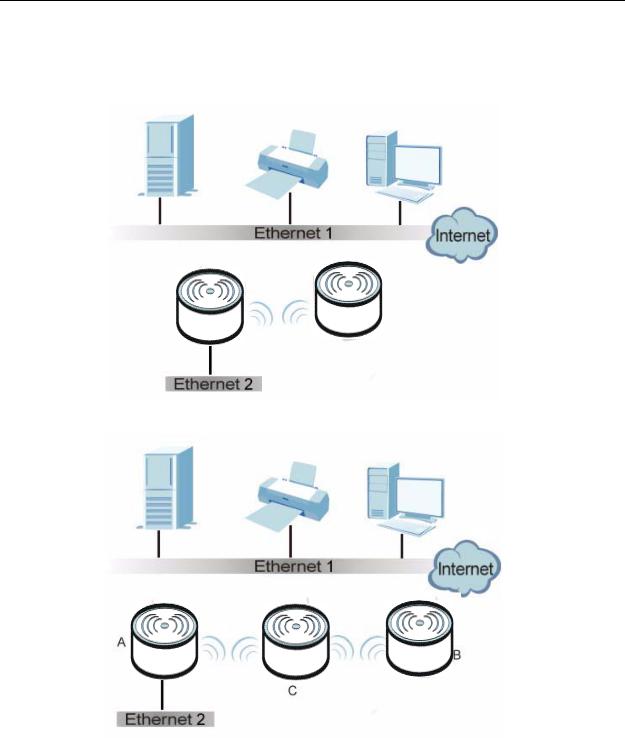
Chapter 1 Introduction
At the time of writing, WDS security is compatible with other ZyXEL access points only. Refer to your other access point’s documentation for details.
Figure 1 Bridge Application
Figure 2 Repeater Application
|
|
|
|
|
|
|
|
|
|
|
|
|
|
|
|
|
|
|
|
|
|
|
|
|
|
|
|
|
|
|
|
|
|
|
|
|
|
|
19 |
NWA3000-N Series User’s Guide |
|||||||
|
|
|
|
|
|
|
|

Chapter 1 Introduction
1.2.1.1 Bridge / Repeater Mode Example
In the example below, when both NWA3000-N series APs are in Bridge/Repeater mode, they form a WDS (Wireless Distribution System) allowing the computers in LAN 1 to connect to the computers in LAN 2.
Figure 3 Bridging Example
Be careful to avoid bridge loops when you enable bridging in the NWA3000-N series AP. Bridge loops cause broadcast traffic to circle the network endlessly, resulting in possible throughput degradation and disruption of communications. The following examples show two network topologies that can lead to this problem:
20 |
|
|
NWA3000-N Series User’s Guide |
|
|
|
|
|
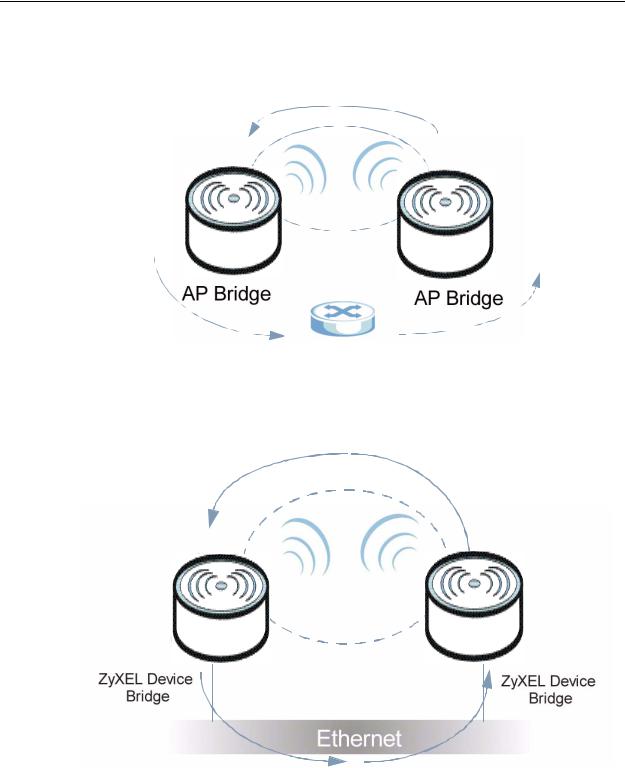
Chapter 1 Introduction
•If two or more NWA3000-N series APs (in bridge mode) are connected to the same hub.
Figure 4 Bridge Loop: Two Bridges Connected to Hub
•If your NWA3000-N series AP (in bridge mode) is connected to a wired LAN while communicating with another wireless bridge that is also connected to the same wired LAN.
Figure 5 Bridge Loop: Bridge Connected to Wired LAN
To prevent bridge loops, ensure that you enable Spanning Tree Protocol (STP) in the Wireless screen or your NWA3000-N series AP is not set to bridge mode while connected to both wired and wireless segments of the same LAN.
|
21 |
NWA3000-N Series User’s Guide |
|
|
|
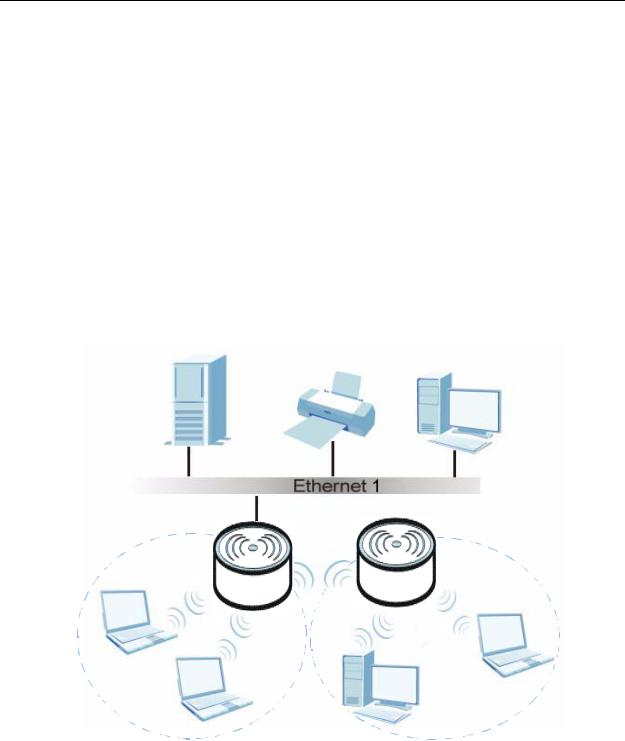
Chapter 1 Introduction
1.2.2 AP + Bridge
In AP + Bridge mode, the NWA3000-N series AP supports both AP and bridge connection at the same time.
In the figure below, A and B use X as an AP to access the wired network, while X and Y communicate in bridge mode.
When the NWA3000-N series AP is in AP + Bridge mode, security between APs (WDS) is independent of the security between the wireless stations and the AP. If you do not enable WDS security, traffic between APs is not encrypted. When WDS security is enabled, both APs must use the same pre-shared key.
Unless specified, the term “security settings” refers to the traffic between the wireless stations and the NWA3000-N series AP.
Figure 6 AP + Bridge Application
Y
A
B
1.2.3 MBSSID
A Basic Service Set (BSS) is the set of devices forming a single wireless network (usually an access point and one or more wireless clients). The Service Set IDentifier (SSID) is the name of a BSS. In Multiple BSS (MBSSID) mode, the
22 |
|
|
NWA3000-N Series User’s Guide |
|
|
|
|
|

Chapter 1 Introduction
NWA3000-N series AP provides multiple virtual APs, each forming its own BSS and using its own individual SSID profile.
You can assign different wireless and security settings to each SSID profile. This allows you to compartmentalize groups of users, set varying access privileges, and prioritize network traffic to and from certain BSSs.
To the wireless clients in the network, each SSID appears to be a different access point. As in any wireless network, clients can associate only with the SSIDs for which they have the correct security settings.
See Section 4.1 on page 55 for an example of using MBSS.
1.3 Management Mode
One NWA3000-N series AP uses Control And Provisioning of Wireless Access Points (CAPWAP, see RFC 5415) to allow one AP to configure and manage up to 24 others. This centralized management can greatly reduce the effort of setting up and maintaining multiple devices.
An NWA3000-N series AP in this group (ZLD-based models) can manage other APs in this group1.
•NWA3160-N
•NWA3550-N
•NWA3560-N
It can also use legacy device information hyper-links to connect to the Web Configurators of the following ZyNOS-based NWA-3000 series APs:
•NWA-3160
•NWA-3163
•NWA-3500
•NWA-3550
•NWA-3166
1.Not all of these models were available at the time of writing.
|
23 |
NWA3000-N Series User’s Guide |
|
|
|
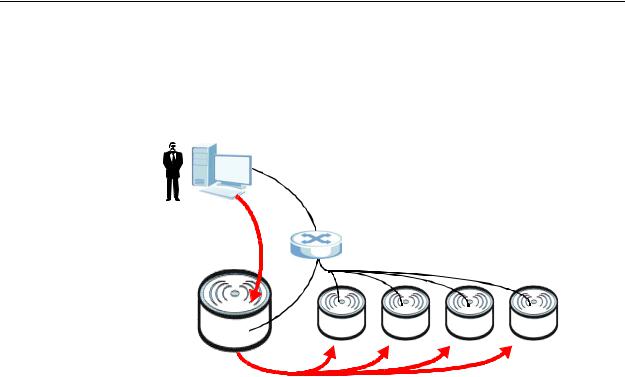
Chapter 1 Introduction
The following figure illustrates a CAPWAP wireless network. The user (U) configures the controller AP (C), which then automatically updates the configurations of the managed APs (M1 ~ M4).
Figure 7 CAPWAP Network Example
U
|
|
|
|
|
|
|
|
|
|
|
|
C |
|
|
|
|
|
|
|
|
|
|
|
|
|
|
|
|
|
|
|
|
|
||
|
|
|
M1 |
|
|
M2 |
M3 |
M4 |
|||
|
|
|
|
|
|||||||
|
|
|
|
|
|||||||
|
|
|
|
|
|||||||
|
|
|
|
|
|
|
|
|
|
|
|
|
|
|
|
|
|
|
|
|
|
|
|
1.4 Ways to Manage the NWA3000-N series AP
You can use the following ways to manage the NWA3000-N series AP.
Web Configurator
The Web Configurator allows easy NWA3000-N series AP setup and management using an Internet browser. This User’s Guide provides information about the Web Configurator.
Command-Line Interface (CLI)
The CLI allows you to use text-based commands to configure the NWA3000-N series AP. You can access it using remote management (for example, SSH or Telnet) or via the console port. See the Command Reference Guide for more information.
24 |
|
|
NWA3000-N Series User’s Guide |
|
|
|
|
|

Chapter 1 Introduction
Console Port
You can use the console port to manage the NWA3000-N series AP using CLI commands. See the Command Reference Guide for more information about the CLI. The default settings for the console port are as follows.
Table 1 Console Port Default Settings
SETTING |
VALUE |
Speed |
115200 bps |
|
|
Data Bits |
8 |
|
|
Parity |
None |
|
|
Stop Bit |
1 |
|
|
Flow Control |
Off |
|
|
File Transfer Protocol (FTP)
This protocol can be used for firmware upgrades and configuration backup and restore.
Simple Network Management Protocol (SNMP)
The NWA3000-N series AP can be monitored by an SNMP manager. See the SNMP chapter in this User’s Guide.
Controller
Set one NWA3000-N series AP to be a controller and set other NWA3000-N series APs to be managed by it.
1.5 Good Habits for Managing the NWA3000-N series AP
Do the following things regularly to make the NWA3000-N series AP more secure and to manage it more effectively.
•Change the password often. Use a password that’s not easy to guess and that consists of different types of characters, such as numbers and letters.
•Write down the password and put it in a safe place.
|
25 |
NWA3000-N Series User’s Guide |
|
|
|

Chapter 1 Introduction
•Back up the configuration (and make sure you know how to restore it). Restoring an earlier working configuration may be useful if the device becomes unstable or even crashes. If you forget your password, you will have to reset the NWA3000-N series AP to its factory default settings. If you backed up an earlier configuration file, you won’t have to totally re-configure the NWA3000-N series AP; you can simply restore your last configuration.
1.6Hardware Connections
See your Quick Start Guide for information on making hardware connections.
26 |
|
|
NWA3000-N Series User’s Guide |
|
|
|
|
|

Chapter 1 Introduction
1.7 LEDs
The following are the LED descriptions for your NWA3000-N series AP.
Figure 8 LEDs
|
|
|
|
|
|
|
|
|
|
|
|
|
|
|
|
|
|
|
|
|
|
|
|
|
|
|
|
|
|
|
|
|
|
|
|
|
|
|
|
Table 2 |
|
LEDs |
|
|
|||
LABEL |
|
|
COLOR |
STATUS |
DESCRIPTION |
||
WLAN |
|
|
Green |
On |
The wireless LAN is active. |
||
|
|
|
|
|
|
|
|
|
|
|
|
|
|
Blinking |
The wireless LAN is active, and transmitting or |
|
|
|
|
|
|
|
receiving data. |
|
|
|
|
|
|
|
|
|
|
|
|
|
Off |
|
The wireless LAN is not active. |
|
|
|
|
|
|
|
|
|
27 |
NWA3000-N Series User’s Guide |
|
|
|

Chapter 1 Introduction
Table 2 LEDs (continued)
LABEL |
COLOR |
STATUS |
DESCRIPTION |
ETHERNET |
Green |
On |
The NWA3000-N series AP has a 10/100 Mbps |
|
|
|
Ethernet connection. |
|
|
|
|
|
|
Blinking |
The NWA3000-N series AP has a 10/100 Mbps |
|
|
|
Ethernet connection and is sending or receiving |
|
|
|
data. |
|
|
|
|
|
Yellow |
On |
The NWA3000-N series AP has a 1000 Mbps |
|
|
|
Ethernet connection. |
|
|
|
|
|
|
Blinking |
The NWA3000-N series AP has a 1000 Mbps |
|
|
|
Ethernet connection and is sending/receiving |
|
|
|
data. |
|
|
|
|
|
|
Off |
The NWA3000-N series AP does not have an |
|
|
|
Ethernet connection. |
|
|
|
|
POWER/SYS |
Green |
On |
The NWA3000-N series AP is receiving power |
|
|
|
and functioning properly. |
|
|
|
|
|
|
Off |
The NWA3000-N series AP is not receiving |
|
|
|
power. |
|
|
|
|
|
Red |
Blinking |
Either |
|
|
|
• If the LED blinks during the boot up process, |
|
|
|
the system is starting up. |
|
|
|
or |
|
|
|
• If the LED blinks after the boot up process, |
|
|
|
the system has failed. |
|
|
|
|
|
|
Off |
The NWA3000-N series AP successfully boots |
|
|
|
up. |
|
|
|
|
28 |
|
|
NWA3000-N Series User’s Guide |
|
|
|
|
|

Chapter 1 Introduction
1.8 Starting and Stopping the NWA3000-N series AP
Here are some of the ways to start and stop the NWA3000-N series AP.
Always use Maintenance > Shutdown or the shutdown command before you turn off the NWA3000-N series AP or remove the power. Not doing so can cause the firmware to become corrupt.
Table 3 Starting and Stopping the NWA3000-N series AP
METHOD |
DESCRIPTION |
Turning on the |
A cold start occurs when you turn on the power to the NWA3000-N |
power |
series AP. The NWA3000-N series AP powers up, checks the |
|
hardware, and starts the system processes. |
|
|
Rebooting the |
A warm start (without powering down and powering up again) |
NWA3000-N series |
occurs when you use the Reboot button in the Reboot screen or |
AP |
when you use the reboot command. The NWA3000-N series AP |
|
writes all cached data to the local storage, stops the system |
|
processes, and then does a warm start. |
|
|
Using the RESET |
If you press the RESET button, the NWA3000-N series AP sets the |
button |
configuration to its default values and then reboots. |
|
|
Clicking |
Clicking Maintenance > Shutdown > Shutdown or using the |
Maintenance > |
shutdown command writes all cached data to the local storage and |
Shutdown > |
stops the system processes. Wait for the device to shut down and |
Shutdown or |
then manually turn off or remove the power. It does not turn off the |
using the shutdown |
power. |
command |
|
|
|
Disconnecting the |
Power off occurs when you turn off the power to the NWA3000-N |
power |
series AP. The NWA3000-N series AP simply turns off. It does not |
|
stop the system processes or write cached data to local storage. |
|
|
The NWA3000-N series AP does not stop or start the system processes when you apply configuration files or run shell scripts although you may temporarily lose access to network resources.
|
29 |
NWA3000-N Series User’s Guide |
|
|
|

Chapter 1 Introduction
30 |
|
|
NWA3000-N Series User’s Guide |
|
|
|
|
|
